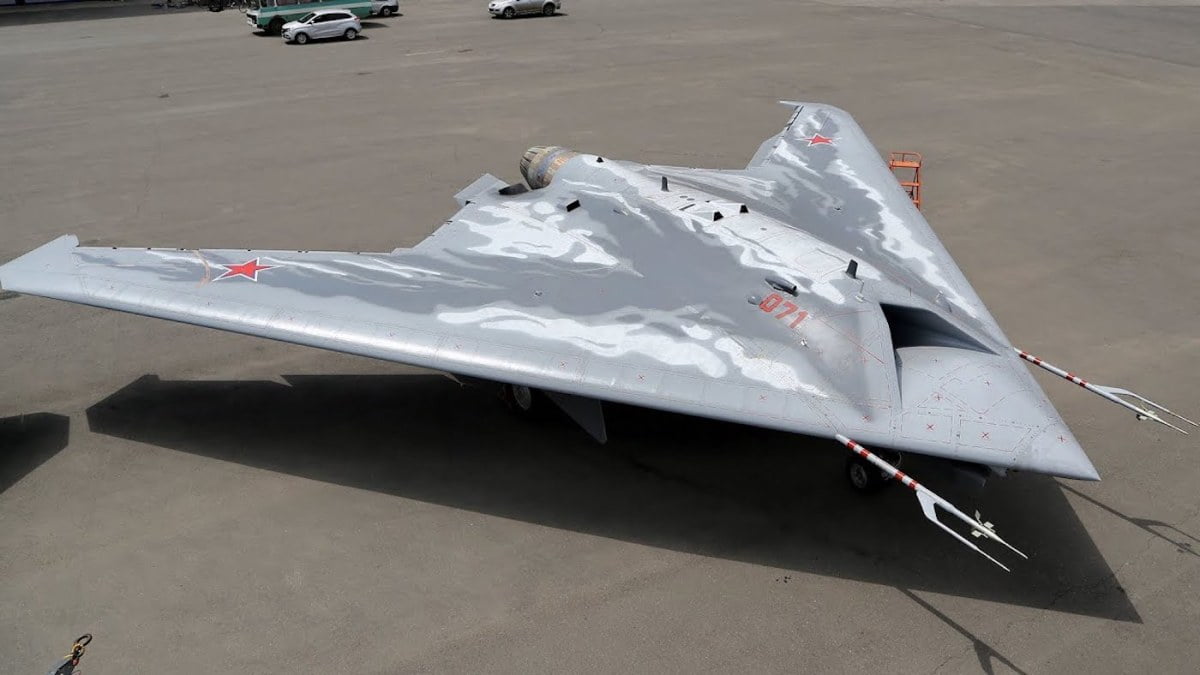U.S. Military Should Panic After Russia Unveils New S-70 Stealth Drone

- The development of this aircraft is something to watch, especially if it regularly flies in formation with the Su-57 and forms a true hunter-killer team to find, fix, and destroy adversaries.
- The Su-57 could fly with four Okhotniks. Earlier this year, the drone and a Su-57 successfully tested this concept over the Ashuluk training grounds.
Russia’s new S-70 drone has all the makings of a real winner, assuming, of course, that Moscow actually manufactures the stealth weapon in sufficient quantities – always a problem with Russia’s military machine these days: Sukhoi S-70 Okhotnik-B drones will be launched from a new Russian amphibious assault ship, akin to a mini aircraft carrier.
The Mitrofan Moskalenko is a 44,000-ton helicopter carrier capable of transporting four S-70 “Hunter” stealth drones. The drones will carry out deep strike missions while also providing targeting data for Tsirkon hypersonic missiles launched from other ships in the fleet. The Okhotnik S-70, on the other hand, will serve as the ship’s eyes, ears, and long-range stealth attack mission.
More on the S-70 Okhotnik Killer UAV
The Okhotnik S-70 is a tough drone that will enter serial production in 2023 and be widely available in 2024. In 2019, the first flying prototype was unveiled. It is quite large for an unmanned system, weighing 20 tonnes and having a wingspan of 46 feet. The S-70 will be powered by the same powerful AL-41F turbofan engine as the 5th generation Su-57 stealth fighter. It has a combat range of 2,500 miles and a top speed of 621 miles per hour as a result.
S-70 Flying With the Su-57 for Full Combat Effect
The Okhotnik will fly alongside the Su-57 as a “loyal wingman,” forging ahead, penetrating enemy defences, spotting intercepting fighter jets, and either launching air-to-surface missiles or sending targeting data back to the Su-57. As a result, situational awareness improves and more munitions can be dropped or launched. The Su-57 could fly with four Okhotniks. Earlier this year, the drone and a Su-57 successfully tested this concept over the Ashuluk training grounds.
Has Similarities to Other Stealth Drones
The Okhotnik is similar to the upcoming Boeing MQ-28 Ghost Bat loyal wingman drone for Australia. The S-70 is a flying wing with no tail, similar to Northrop Grumman’s X-47B drone. Its coating makes it radar-resistant, and its flat nozzle and engine fit into the fuselage to improve stealth. There are no visible antennas or inlets. A payload of 4,400 pounds is carried by two internal weapons bays.
Air-to-Ground Missiles Appear to Have Worked
According to Janes Defense, the drone hit ground targets in a precision-strike test in May. The missile was most likely a Kh-59MK2 standoff cruise missile, which the Su-57 is also capable of firing. This satellite-guided cruise missile is 14 feet long and has a range of 310 miles.
How Stealthy Is It?
The Su-57 is not the best stealth fighter in the world, and its ability to avoid radar is questioned. The S-70 Okhotnik’s stealth is likely lower than that of the MQ-28 Ghost Bat combat UAV or the X-47B.
Will The Okhotnik and Su-57 Fly Together on a Regular Basis?
Because Russia does not have an operational aircraft carrier, the future amphibious assault ship will be an additional means of delivering combat drones to battle. This configuration may suit the Russian Navy better than the Air Force. It’s unclear how the Okhotnik could fly in loyal wingman mode alongside the Su-57 if one aircraft launches from a ship and the other from the ground. To fly in formation, both aircraft would have to take off from nearby locations. However, because the Okhotnik has long-range capabilities, the loyal wingman concept remains viable if the warplanes can meet in the air.
One must admit that the Okhotnik is carrying out various testing missions in such a way that it will one day fly for the Russian Air Force and Navy. It can carry a large number of weapons and has a long range. The development of this aircraft is something to watch, especially if it regularly flies in formation with the Su-57 and forms a true hunter-killer team to find, fix, and destroy adversaries.
Brent M. Eastwood, PhD, is the author of Humans, Machines, and Data: Future Trends in Warfare and is now the Defense and National Security Editor at 1945. He is an Emerging Threats expert and a former infantry officer in the United States Army.







Facebook Comments